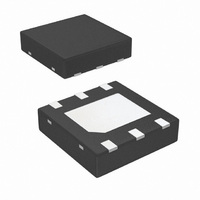LM2832YSD/NOPB National Semiconductor, LM2832YSD/NOPB Datasheet - Page 13

LM2832YSD/NOPB
Manufacturer Part Number
LM2832YSD/NOPB
Description
IC REGULATOR BUCK 2A 6-LLP
Manufacturer
National Semiconductor
Type
Step-Down (Buck)r
Datasheet
1.LM2832YSDNOPB.pdf
(27 pages)
Specifications of LM2832YSD/NOPB
Internal Switch(s)
Yes
Synchronous Rectifier
No
Number Of Outputs
1
Voltage - Output
0.6 ~ 4.5 V
Current - Output
2A
Frequency - Switching
550kHz
Voltage - Input
3 ~ 5 V
Operating Temperature
-40°C ~ 125°C
Mounting Type
Surface Mount
Package / Case
6-LLP
For Use With
LM2832YSD EVAL - BOARD EVAL LM2832YSD
Lead Free Status / RoHS Status
Lead free / RoHS Compliant
Power - Output
-
Other names
*LM2832YSD/NOPB
LM2832YSD
LM2832YSDTR
LM2832YSD
LM2832YSDTR
Design Guide
Sanyo POSCAP, Tantalum or Niobium, Panasonic SP, and
multilayer ceramic capacitors (MLCC) are all good choices
for both input and output capacitors and have very low ESL.
For MLCCs it is recommended to use X7R or X5R type
capacitors due to their tolerance and temperature character-
istics. Consult capacitor manufacturer datasheets to see
how rated capacitance varies over operating conditions.
OUTPUT CAPACITOR
The output capacitor is selected based upon the desired
output ripple and transient response. The initial current of a
load transient is provided mainly by the output capacitor. The
output ripple of the converter is:
When using MLCCs, the ESR is typically so low that the
capacitive ripple may dominate. When this occurs, the out-
put ripple will be approximately sinusoidal and 90˚ phase
shifted from the switching action. Given the availability and
quality of MLCCs and the expected output voltage of designs
using the LM2832, there is really no need to review any other
capacitor technologies. Another benefit of ceramic capaci-
tors is their ability to bypass high frequency noise. A certain
amount of switching edge noise will couple through parasitic
capacitances in the inductor to the output. A ceramic capaci-
tor will bypass this noise while a tantalum will not. Since the
output capacitor is one of the two external components that
control the stability of the regulator control loop, most appli-
cations will require a minimum of 22 µF of output capaci-
tance. Capacitance often, but not always, can be increased
significantly with little detriment to the regulator stability. Like
the input capacitor, recommended multilayer ceramic ca-
pacitors are X7R or X5R types.
CATCH DIODE
The catch diode (D1) conducts during the switch off-time. A
Schottky diode is recommended for its fast switching times
and low forward voltage drop. The catch diode should be
chosen so that its current rating is greater than:
The reverse breakdown rating of the diode must be at least
the maximum input voltage plus appropriate margin. To im-
prove efficiency, choose a Schottky diode with a low forward
voltage drop.
I
D1
= I
(Continued)
OUT
x (1-D)
13
OUTPUT VOLTAGE
The output voltage is set using the following equation where
R2 is connected between the FB pin and GND, and R1 is
connected between V
is 10kΩ. When designing a unity gain converter (Vo = 0.6V),
R1 should be between 0Ω and 100Ω, and R2 should be
equal or greater than 10kΩ.
PCB LAYOUT CONSIDERATIONS
When planning layout there are a few things to consider
when trying to achieve a clean, regulated output. The most
important consideration is the close coupling of the GND
connections of the input capacitor and the catch diode D1.
These ground ends should be close to one another and be
connected to the GND plane with at least two through-holes.
Place these components as close to the IC as possible. Next
in importance is the location of the GND connection of the
output capacitor, which should be near the GND connections
of CIN and D1. There should be a continuous ground plane
on the bottom layer of a two-layer board except under the
switching node island. The FB pin is a high impedance node
and care should be taken to make the FB trace short to avoid
noise pickup and inaccurate regulation. The feedback resis-
tors should be placed as close as possible to the IC, with the
GND of R1 placed as close as possible to the GND of the IC.
The V
inductor and any other traces that are switching. High AC
currents flow through the V
should be as short and wide as possible. However, making
the traces wide increases radiated noise, so the designer
must make this trade-off. Radiated noise can be decreased
by choosing a shielded inductor. The remaining components
should also be placed as close as possible to the IC. Please
see Application Note AN-1229 for further considerations and
the LM2832 demo board as an example of a four-layer
layout.
OUT
trace to R2 should be routed away from the
O
V
and the FB pin. A good value for R2
REF
IN
= 0.60V
, SW and V
OUT
traces, so they
www.national.com











